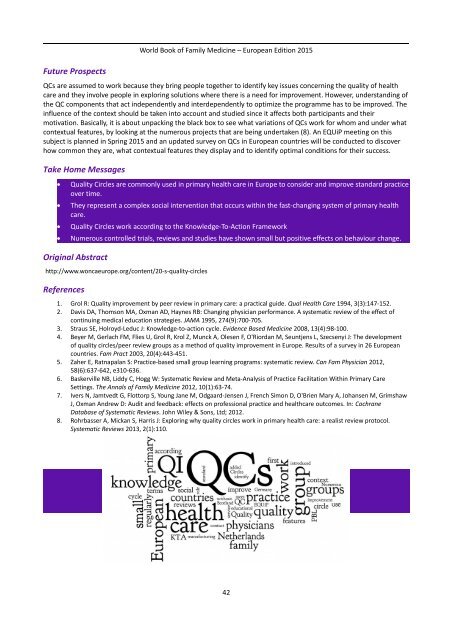Family Medicine
U8VnW
U8VnW
Create successful ePaper yourself
Turn your PDF publications into a flip-book with our unique Google optimized e-Paper software.
World Book of <strong>Family</strong> <strong>Medicine</strong> – European Edition 2015<br />
Future Prospects<br />
QCs are assumed to work because they bring people together to identify key issues concerning the quality of health<br />
care and they involve people in exploring solutions where there is a need for improvement. However, understanding of<br />
the QC components that act independently and interdependently to optimize the programme has to be improved. The<br />
influence of the context should be taken into account and studied since it affects both participants and their<br />
motivation. Basically, it is about unpacking the black box to see what variations of QCs work for whom and under what<br />
contextual features, by looking at the numerous projects that are being undertaken (8). An EQUiP meeting on this<br />
subject is planned in Spring 2015 and an updated survey on QCs in European countries will be conducted to discover<br />
how common they are, what contextual features they display and to identify optimal conditions for their success.<br />
Take Home Messages<br />
<br />
<br />
<br />
<br />
Quality Circles are commonly used in primary health care in Europe to consider and improve standard practice<br />
over time.<br />
They represent a complex social intervention that occurs within the fast-changing system of primary health<br />
care.<br />
Quality Circles work according to the Knowledge-To-Action Framework<br />
Numerous controlled trials, reviews and studies have shown small but positive effects on behaviour change.<br />
Original Abstract<br />
http://www.woncaeurope.org/content/20-s-quality-circles<br />
References<br />
1. Grol R: Quality improvement by peer review in primary care: a practical guide. Qual Health Care 1994, 3(3):147-152.<br />
2. Davis DA, Thomson MA, Oxman AD, Haynes RB: Changing physician performance. A systematic review of the effect of<br />
continuing medical education strategies. JAMA 1995, 274(9):700-705.<br />
3. Straus SE, Holroyd-Leduc J: Knowledge-to-action cycle. Evidence Based <strong>Medicine</strong> 2008, 13(4):98-100.<br />
4. Beyer M, Gerlach FM, Flies U, Grol R, Krol Z, Munck A, Olesen F, O'Riordan M, Seuntjens L, Szecsenyi J: The development<br />
of quality circles/peer review groups as a method of quality improvement in Europe. Results of a survey in 26 European<br />
countries. Fam Pract 2003, 20(4):443-451.<br />
5. Zaher E, Ratnapalan S: Practice-based small group learning programs: systematic review. Can Fam Physician 2012,<br />
58(6):637-642, e310-636.<br />
6. Baskerville NB, Liddy C, Hogg W: Systematic Review and Meta-Analysis of Practice Facilitation Within Primary Care<br />
Settings. The Annals of <strong>Family</strong> <strong>Medicine</strong> 2012, 10(1):63-74.<br />
7. Ivers N, Jamtvedt G, Flottorp S, Young Jane M, Odgaard-Jensen J, French Simon D, O'Brien Mary A, Johansen M, Grimshaw<br />
J, Oxman Andrew D: Audit and feedback: effects on professional practice and healthcare outcomes. In: Cochrane<br />
Database of Systematic Reviews. John Wiley & Sons, Ltd; 2012.<br />
8. Rohrbasser A, Mickan S, Harris J: Exploring why quality circles work in primary health care: a realist review protocol.<br />
Systematic Reviews 2013, 2(1):110.<br />
42


